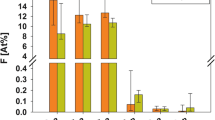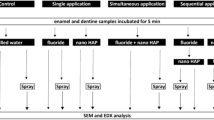Abstract
SINCE the early observations1 on reduction of caries with increasing fluoride concentrations in drinking water, the tacit assumption was made that fluoride incorporated in dental enamel acts as a cariostatic agent. An appealing explanation for the possible mechanism involved is based on the nature of the enamel mineral of which hydroxyapatite (OHA), Ca5OH(PO4)3, is considered to be the prototype. Replacement of fluoride for the hydroxyl would yield fluorapatite (FA) which has a lower solubility. Analyses of surface layers of enamel, however, show that the fluoride contents are far below the level expected for FA. It is relevant then to ascertain to what extent partial substitution of the fluoride for the hydroxyl group in HA affects its solubility.
This is a preview of subscription content, access via your institution
Access options
Subscribe to this journal
Receive 51 print issues and online access
$199.00 per year
only $3.90 per issue
Buy this article
- Purchase on Springer Link
- Instant access to full article PDF
Prices may be subject to local taxes which are calculated during checkout
Similar content being viewed by others
References
Dean, H. T., Arnold, F. A., and Elvove, E., Publ. Hlth Rep. Wash., 57, 1155 (1942).
Driessens, F. C. M., Nature, 243, 420 (1973).
Duff, E. J., J. chem. Soc., A., 1895 (1971).
Moreno, E. C., in International Symposium on Structural Properties of Hydroxyapatite and Related Compounds (edit. by Young, R. A., and Brown, W. E.), chapter 15 (Gordon and Breach, New York, 1968).
Kay, M. I., Young, R. A., and Posner, A. S., Nature, 204, 1050 (1964).
Young, R. A., and Elliott, J. C., Archs oral Biol., 11, 699 (1966).
Van der Lugt, W., Knottnerus, D. I. M., and Young, R. A., Caries Res., 4, 89 (1970).
Gregory, T. M., Moreno, E. C., and Brown, W. E., J. Res. natn. Bur. Stand., 74, A461 (1970).
Aasenden, R., and Moreno, E. C., Archs oral Biol., 16, 1413 (1971).
Isaac, S., Brudevold, F., Smith, F. A., and Gardner, D. E., J. dent. Res., 37, 318 (1958).
Munksgaard, E. C., and Bruun, C., Archs oral Biol., 18, 735 (1973).
Aasenden, R., and Peebles, T. C., Archs oral Biol. (in the press).
Ericson, T., and Ericsson, Y., Helv. odont. Acta, 11, 10 (1967).
Author information
Authors and Affiliations
Rights and permissions
About this article
Cite this article
MORENO, E., KRESAK, M. & ZAHRADNIK, R. Fluoridated Hydroxyapatite Solubility and Caries Formation. Nature 247, 64–65 (1974). https://doi.org/10.1038/247064a0
Received:
Revised:
Issue Date:
DOI: https://doi.org/10.1038/247064a0
This article is cited by
-
Corrosion Behavior of Fluorine-Doped Calcium Phosphorus Coating on AZ31 Alloy with Various Chemical Conversion Parameters
Journal of Materials Engineering and Performance (2024)
-
Improved mineralization of dental enamel by electrokinetic delivery of F− and Ca2+ ions
Scientific Reports (2023)
-
Comparison of surface roughness of root cementum and orthodontically induced root resorption craters from high- and low-fluoridation areas: a 3D confocal microscopy study
Progress in Orthodontics (2022)
-
Synthesis of Fluorinated Urchin-like Serried Hydroxyapatite with Improved Water Sorption-Solubility and Bioactivity for Dental Composites
Chemical Research in Chinese Universities (2021)
-
Principles of fluoride toxicity and the cellular response: a review
Archives of Toxicology (2020)
Comments
By submitting a comment you agree to abide by our Terms and Community Guidelines. If you find something abusive or that does not comply with our terms or guidelines please flag it as inappropriate.



